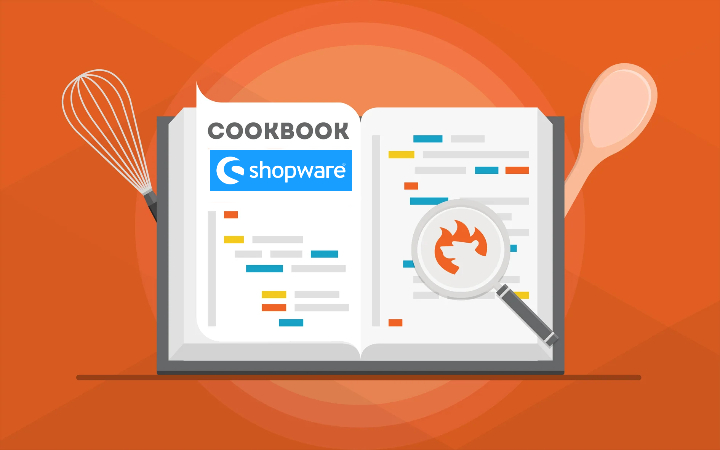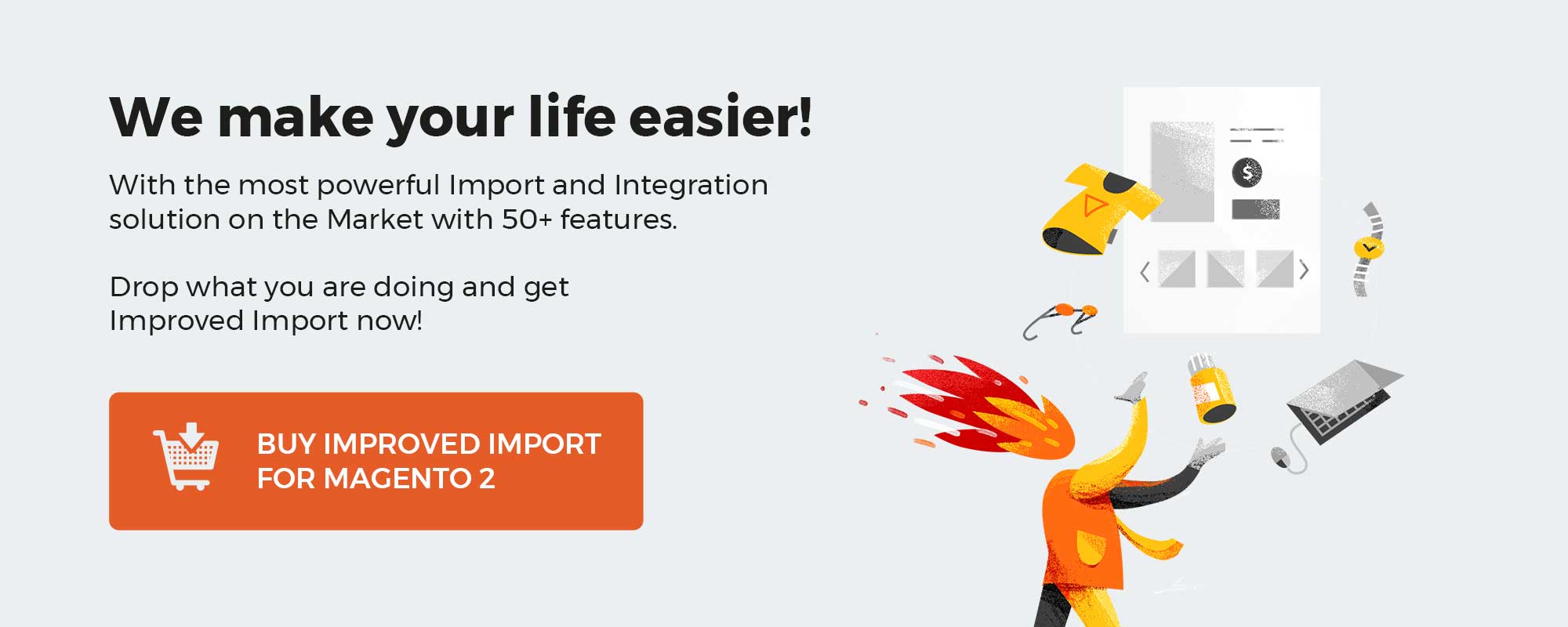
Shopware is working incredibly hard to win over merchants not only in Germany, where it originates from a small and unknown project, but also all over the globe. In the following article, we shed light upon the e-commerce platform, which gains more and more market share across the EU countries. You will learn what Shopware is and why it is worth planning your migration to Shopware 6 from other e-commerce platforms.
Note that this article starts the series of Shopware cookbook blog posts dedicated to the platform. We’ve already explored the administration interface of its cloud version, and now it’s time to provide more facts about the system. So, what is Shopware?

Get Improved Import & Export for Shopware by Firebear Studio
Explore Shopware
Table of contents
What is Shopware?
Shopware is an open-source platform established in Germany in 2000. Since 2016, it has been fully open source. The great thing about Shopware is that was developed by the people who were using it. The not-so-great thing is that it happened more than two decades ago when e-commerce technologies were fairly limited.
As a result, the quality of the software was relatively high, the usability was about to impress everyone, but each new year the platform was sinking into the sand of outdated technologies. The older it became the more difficult it was to follow the highest requirements in terms of design and technology. Unless one day when people behind Shopware decided to clear the decks.
The owners’ mission was to provide every Shopware merchant with the ability to establish a personalized look. However, with the release of Shopware 5, it was clear that all the attempts to get a more attractive and engaging webshop experience that helps merchants keep in front of the competitors require more and more resources. And in the long term, the entire platform won’t be commercially viable.
Despite the obvious stalemate that was looming over the horizon, Shopware has contracted a couple of big brands. Big German shops that incorporated Shopware as an e-commerce platform were ThyssenKrupp, Lufthansa, and Euronics. As for global companies, they included M&M’s, L’Oreal, Haribo, and Discovery Channel. It was a huge success for a once relatively small e-commerce system. However, the ambitions significantly outweighed the gainings.
In view of this, Shopware 6 emerged on the global map of e-commerce platforms. It was a completely new system that inherited the best Shopware features but implemented them following the latest technologies. Something similar happened to Magento when its second version was born. But the latter is turning more and more towards huge corporate clients while the interests of smaller merchants are neglected.
As for Shopware in general and Shopware 6 in particular, the platform is aimed at clients of all sizes. It delivers outstanding flexibility where you need it and admin-friendly solutions where complexity is not necessary. You can find more information about the system’s latest version in this article – The New Era of Open Source E-Commerce. Before going any further, let’s summarize the chapter and define what Shopware is.
Shopware is an open-source e-commerce platform based on a modern technology stack with the latest version powered by Symfony and Vue.js. It is focused on an API-first approach and provides the opportunity to run different sales channels.
Shopware 5 and Shopware 6 are the two most popular versions used by local German merchants and companies all over the globe. According to the official source, they are preferred by almost 100k brands.
[embedded content]
Why migrate to Shopware?
Now let’s look at the advantages of Shopware 6 and explain why it is worth planning your migration to Shopware 6 from other e-commerce platforms and especially Magento. The system’s rising popularity is associated with numerous advantages:
- Extended CMS Options. You may argue that top CMS platforms offer decent content management capabilities. However, some of them still require technical support or additional modules to provide you with what your business demands. Shopware lets you create flexible content pages without the need for either third-party involvement or supplementary tools. It works in its default setup, providing you with enough freedom. It is only necessary to provide expressive images and relevant content to tell a story that responds to the emotional aspects of your potential buyers.
- Drag-&-Drop Instruments. What can be more admin-friendly than a drag-&-drop interface? Shopware delivers this approach to its backend so that you can move various components, including products, banners, product blocks, and rich media, creating customized layouts. While not all e-commerce systems offer the same conditions, built-in drag-&-drop instruments are a valuable advantage introduced in Shopware.
- Multiple Stores. Shopware provides the ability to manage multiple stores from the same cockpit. Although Magento offers the same options, it is still a strong advantage over other systems, especially considering the fact that product and catalog management is super easy. You can even create an individualized experience based on product streams that respond to the shopping behavior of visitors. It looks as follows: You can create product groups and when a visitor selects a particular filter a personalized product stream displays.
- Extensive Marketing Features. Shopware offers numerous marketing functionalities out of the box. Therefore, you don’t need to install additional tools to get the basic features. For instance, it is possible to segment customers based on their shopping behavior, create beautiful banners with CTA buttons and texts, as well as run loyalty programs.
- Advanced Scalability. Since Shopware offers inbuilt tooling, can easily increase the performance and scalability of your e-commerce website when necessary.
- Built-in SEO Tools. Every Shopware shop comes with a bunch of SEO tools, such as SEO-friendly URLs, meta titles and descriptions, Rich Snippets, built-in sitemap, redirects, canonicals, etc. Thus, it is possible to help your store pages get to the top search results.
As you can see, Shopware has lots of features that are also available in Magento in one form or another. However, the former has a strong competitive advantage that is enough for planning your migration to Shopware 6.
While Magento 2 switches its vector to bigger corporate clients, Shopware 6 is open for everyone. After Adobe purchased Magento, many people were afraid of that move. And the worst nightmares are gradually put into life.
In its turn, Shopware 6 is suitable for small and big companies. As you can see, some huge brands already prefer this platform since it is powerful and easy to use.
Furthermore, many developers who were initially associated with Magento now switch their attention to Shopware. For instance, the former Magento lead evangelist Ben Marks has recently joined Shopware. Here at Firebear, we also spend more time on the Shopware-related content for our blog and work on the import and export solution for the platform.
The e-commerce market is gradually changing but this process speeds up every year. Therefore, it is necessary to act fast and make well-thought decisions. To help you with that, we’d like to introduce you to the disadvantages of Shopware.
- Time. You need more time to build a Shopware website than, for instance, a WooCommerce storefront just because the system is more complex and feature-rich. You have to pay for its powerful tools with the additional time and effort necessary for the store development. Shopware also requires serious server power that is an investment too.
- External Markets. Although Shopware 6 offers built-in tools necessary for running an international storefront, some options are very limited. Magento does a better job but it is only a matter of time when similar conditions will be recreated in Shopware.
- Admin Roles. With a relatively simple system of roles and rights, Shopware makes it difficult to divide admins into groups without external tooling. However, the basic functionality may still be enough.
- Ecosystem. Since Shopware used to be a local platform popular within the German market, it has an ecosystem that is much smaller than the one associated with Magento that has been always used globally. But we believe that the recent changes within the Magento world will accelerate the growth of the Shopware platform and its impact on the entire e-commerce universe.
These are just a few disadvantages associated with Shopware. Are they enough for staying on your current e-commerce platform? We believe that the advantages are way more valuable. If you still hesitate, read other materials about Shopware in our blog.
Shopware 6 Essentials FAQ
How to create a Shopware account?
Now, when you are familiar with what Shopware is and why it is necessary to migrate to the platform, you need to create a Shopware account. Visit the registration page, hit the Register Now link, and fill in the form. After receiving a confirmation email, follow the instructions provided in it.
What about a Shopware ID?
Don’t worry, you will receive your Shopware ID during the registration automatically.
What is Shopware master data?
Since Shopware is an e-commerce platform, it stores all the information about your company provided to the system. All these facts are called Shopware master data. They usually include physical addresses, phone numbers, emails, and other information added to the registration form.
How to add a new Shopware shop?
We’ve mentioned above that the ability to run several shops is an important advantage of Shopware. So, let’s see how to add one. Your merchant area is a place where the appearance of a new Shopware 6 shop takes place. You need to click the corresponding link to activate the process. After that, choose the type of your new shop (a cloud storefront or an on-premise installation) and provide all the information the system requires.
How to add a payment method to your Shopware account?
In Shopware 6, you need to add a payment method for your internal purposes. Go to Basic Information -> Accounting and choose PayPal, credit card, or direct debit as a way to transfer funds to your account.
How to create a deposit in Shopware?
After an internal payment method is configured and turned on, you can create a deposit to purchase extensions and themes. Go to your Merchant Area -> Shops and choose a shop to provide funds there. Click Open Account Details and transfer a deposit that covers the amount of your future purchase.
How to purchase Shopware extensions?
The system introduces two ways for purchasing extensions and themes for your Shopware 6 website: Shopware Marketplace or Plugin Manager. No matter which one you choose, you need to create a deposit, select a tool you want to buy, and complete the checkout. As we’ve already mentioned, the deposit should be equal to the amount of your future purchase.
How to get support in Shopware?
Contact shopware to get answers and help. Try the following email if you have questions regarding accounting and financial services: financial.services@shopware.com. Also, call +49 2555 9288 510 to discuss the same issues. If you want to ask about account or license issues, write to info@shopware.com or call +49 2555 9288 50.
How to automate import and export processes in Shopware 6?
As we’ve mentioned above, some areas of Shopware are still weak. However, even more-experienced Magento has a huge room for improvement, especially in the area of data transfers. You need a third-party tool to automate import and export processes associated with your Shopware website. For instance, you may try the Improved Import & Export extension to manage recurring data transfers. Note that it requires no interaction on the admin side if you configure it properly. Create schedules to launch the corresponding import and export processes automatically, following the specified criteria.
How to migrate to Shopware 6?
Perhaps, it is one of the most important aspects for merchants to decide whether to change the current platform or not. If you need to move your existing storefront to Shopware, the Improved Import & Export module is at your service. It will help you move your existing website to the new platform no matter it is based on other e-commerce systems or Shopware’s previous versions. Since we also offer export solutions for systems like Magento and Shopify, you can simplify your data transfers between them and Shopware. Contact us for more information.
How to integrate Shopware 6 with external systems?
You can also use the Improved Import & Export extension to synchronize your Shopware 6 website with ERPs, CRMs, accounting tools, and other similar platforms. As we’ve just mentioned above, it lets you run repetitive import and export processes based on schedules and mapping presets. The latter ones are used to modify data according to the requirements of your Shopware store during import as well as follow the rules of the connected platform during export. If the tool is properly configured, no interaction on the admin side is needed.
Get Improved Import & Export for Shopware by Firebear Studio
Explore Shopware







